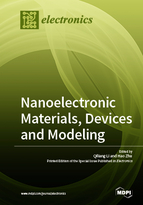Partial Isolation Type Saddle-FinFET(Pi-FinFET) for Sub-30 nm DRAM Cell Transistors
Round 1
Reviewer 1 Report
Title: Partial Isolation Type Saddle-FinFET (Pi-FinFET) for Sub-30 nm DRAM Cell Transistors.
Summary of the paper: The paper proposes a new technique (i.e., with a partial isolation region under the storage node of conventional S-FinFET) to effectively resolve the issues occurring under the capacitor node of dynamic random-access memory (DRAM) cell and depicts how its structure was superior to generic S-FinFETs in terms of short channel effect (SCE), subthreshold slope (SS), and gate-induced drain leakage (GIDL).
Strong points of the paper: A new approach proposed by the authors to effectively resolve the challenges occurring under the capacitor node of DRAM cell is an interesting one. The language of the paper is easy to follow and understandable.
Weakness of the paper: The paper has several weaknesses that are outlined as follows:
· Some acronym should be defined before usage in the paper such as S/D and DIBL (see abstract).
· Figure 2 and 4 are very small and difficult to follow and understand the message the message the authors are trying to convey.
· Figure 4a, Lin [nm] axis is confusing since two separate data are represented. Can the authors clearly distinguish them to enhance understanding of them.
· The authors should be specific at which point Subthreshold Slope (SS) remains constant in Figure 4b.
· Figures 5 and 6 should be improved for enhanced readability.
· There is no outline of the paper.
Author Response
We appreciate the reviewer’s comments as valuable suggestions and revised the paper according to them.
Author Response File: ![]() Author Response.pdf
Author Response.pdf
Reviewer 2 Report
This is an "all-simulation" paper. The paper would gain much more value by coupling device simulations with experiments.
The acronyms have to be spelled out the first time they are used in the document (e.g., DIBL in the abstract).
The variable-names should be written with their pertinent subscripts form (e.g., check Ion and Ioff in the Introduction).
Please put a space between a number and its unit (e.g., “1.8V to -0.4V” should be replaced with “1.8 V to -0.4 V”).
To better contextualize the relevance of this study within the state-of-art, a sentence should be added in the Introduction about the RF performance of the FinFET technology with a few relevant references (e.g., “A comprehensive review on microwave FinFET modeling for progressing beyond the state of art,” Solid State Electron 2013)
Author Response
We appreciate the reviewer’s comments as valuable suggestions and revised the paper according to them as follows:
Author Response File: ![]() Author Response.pdf
Author Response.pdf
Round 2
Reviewer 1 Report
- I think there are still issues with Figures 4a & 4b. At the x-axis the authors left out Lin [nm] and rather use the Ratio of Lin to Lg [%] instead. However, in page 4, the authors started explaining Lin with respect to 15 nm which is not represented in the figures but rather assumed. It will be nice if the authors will clearly explain the figures with respect to the data shown in the figure.
- The reviewer thinks that other comments have been addressed if the above minor revision is taken care of.
Author Response
We appreciate the reviewer’s comments as valuable suggestions and revised the paper according to them.
Author Response File: ![]() Author Response.pdf
Author Response.pdf
Reviewer 2 Report
Although I still believe that this paper would gain much more values by coupling device simulations with experiments, the revised paper is publishable. I have no further comments.
Author Response
We appreciate the reviewer’s comments as valuable suggestions and revised the paper according to them.
Author Response File: ![]() Author Response.pdf
Author Response.pdf



